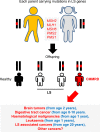Constitutional mismatch repair-deficiency: current problems and emerging therapeutic strategies
- PMID: 30459937
- PMCID: PMC6226037
- DOI: 10.18632/oncotarget.26249
Constitutional mismatch repair-deficiency: current problems and emerging therapeutic strategies
Abstract
Mismatch repair (MMR) proteins remove errors from newly synthesized DNA, improving the fidelity of DNA replication. A loss of MMR causes a mutated phenotype leading to a predisposition to cancer. In the last 20 years, an increasing number of patients have been described with biallelic MMR gene mutations in which MMR defects are inherited from both parents. This leads to a syndrome with recessive inheritance, referred to as constitutional mismatch repair-deficiency (CMMRD). CMMRD is a rare childhood cancer predisposition syndrome. The spectrum of CMMRD tumours is broad and CMMRD-patients possess a high risk of multiple cancers including hematological, brain and intestinal tumors. The severity of CMMRD is highlighted by the fact that patients do not survive until later life, emphasising the requirement for new therapeutic interventions. Many tumors in CMMRD-patients are hypermutated leading to the production of truncated protein products termed neoantigens. Neoantigens are recognized as foreign by the immune system and induce antitumor immune responses. There is growing evidence to support the clinical efficacy of neoantigen based vaccines and immune checkpoint inhibitors (collectively referred to as immunotherapy) for the treatment of CMMRD cancers. In this review, we discuss the current knowledge of CMMRD, the advances in its diagnosis, and the emerging therapeutic strategies for CMMRD-cancers.
Keywords: CMMRD; childhood cancer; immunotherapy; mismatch repair; predisposition syndrome.
Conflict of interest statement
CONFLICTS OF INTEREST The author declares that she has no competing interests.
Figures


References
-
- Leicher LW, Lammertink MHA, Offerman SR, Morreau H, de Jong MM, de Groot JWB, van Westreenen HL, Vasen HFA, de Vos Tot Nederveen Cappel WH. Consequences of testing for mismatch repair deficiency of colorectal cancer in clinical practice. Scand J Gastroenterol. 2018;53:632–636. - PubMed
-
- Haraldsdottir S, Roth R, Pearlman R, Hampel H, Arnold CA, Frankel WL. Mismatch repair deficiency concordance between primary colorectal cancer and corresponding metastasis. Fam Cancer. 2016;15:253–260. - PubMed
-
- Chika N, Fukuchi M, Suzuki O, Ito T, Yamamoto A, Ishiguro T, Kumagai Y, Ishibashi K, Mochiki E, Ishida H. [Incidence and Characteristics of Mismatch Repair Protein Deficiency in Elderly Gastric Cancer Patients]. [Article in Japanese] Gan To Kagaku Ryoho. 2016;43:1298–1300. - PubMed
-
- Andrici J, Farzin M, Sioson L, Clarkson A, Watson N, Toon CW, Gill AJ. Mismatch repair deficiency as a prognostic factor in mucinous colorectal cancer. Mod Pathol. 2016;29:266–274. - PubMed
-
- Urganci N, Genc DB, Kose G, Onal Z, Vidin OO. Colorectal Cancer due to Constitutional Mismatch Repair Deficiency Mimicking Neurofibromatosis I. Pediatrics. 2015;136:e1047–1050. - PubMed
Publication types
LinkOut - more resources
Full Text Sources
Other Literature Sources
Molecular Biology Databases

